As if turning the world upside down wasn’t enough, it turns out pandemic life also messes with your skin. Last week I talked about how to deal with the irritation that comes from washing your hands so much. This week, I’m talking about Mask Face – the irritation and breakouts that can happen when you wear cloth face masks, surgical masks or respirators.
Again, I went and asked lots of dermatologists for their tips on how to deal with skin issues when it comes to wearing masks – here are their tips.
Related post: Pandemic Skincare: How to Fix Dry Hands (Dermatologist Advice) (with Video)
The video is here on YouTube, keep scrolling for the written version!
What do masks do to your skin?
Skin issues can come up when you wear any sort of mask on your face – cloth masks that you might wear for a few hours to the store, or surgical masks that healthcare workers normally wear, or hard respirators that a lot of healthcare workers who work closely with COVID-19 patients are wearing now for hours on end (Australians are very familiar with these after the bushfires last year).
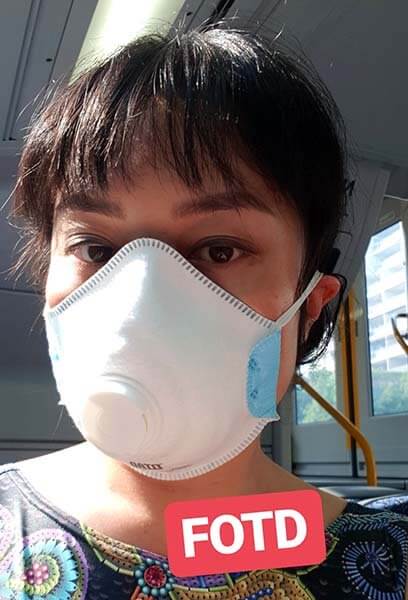
With the looser sorts of masks (cloth and surgical masks), you might see some skin irritation – dryness, itching and redness – known as irritant contact dermatitis. This happens because of the extra heat, moisture from your breath and from sweating, and friction of the mask rubbing against your skin.
You can also get acne from masks rubbing on your skin and physically blocking your pores. This is known as acne mechanica.
“The moisture that’s getting trapped under the mask from the humidity of our breath and increased sweating, plus the actual occlusion of the mask alone is causing increased rates of acne.”
— Dr Papri Sarkar, Dermatologist
Respirators are a lot harder and fit onto skin more tightly, which means you can end up with hives and pressure sores, indented skin, raw patches and blisters.
Components of the mask like adhesives, residual formaldehyde in N95 masks and rubber straps can also cause irritation and allergies. These can lead to red and inflamed skin, itching and rashes.
Tips for wearing masks
Avoid heavy makeup or foundation under the mask
Heavy makeup and foundation can cause acne and breakouts. Even if your skin doesn’t usually react to these products, they might when combined with the extra pressure and friction from the mask.
Protect key spots from friction
Applying a moisturiser or barrier cream like zinc oxide or dimethicone-based 3M Cavilon before putting on the mask can help. This is particularly useful on areas where the mask rubs – on most people, the most common places are the bridge of your nose, the sides of your face and under the chin.
“To counter this, you need some sort of barrier to protect the skin. You can use Duoderm or a gentle skin tape over the nasal bridge and cheeks where the mask rests. You can also use a barrier cream like zinc oxide.”
— Dr Joyce, Dermatologist
Be careful if you’re a healthcare worker using respirators since using products right before putting on the mask can affect the ability of the mask to form a tight seal against your skin – it’s a good idea to check if this applies to you.
“Caution – if you are a healthcare professional wearing PPE do not [use creams] immediately prior to fitting your mask as it may affect the quality of the seal.”
— Dr Anjali Mahto, Dermatologist
You can also use protective dressings like hydrocolloid bandages and skin tapes on areas where there’s rubbing and on wounds.
Related post: How Do Hydrocolloid Bandages and Acne Patches Work?
Hacks for pain behind your ears
There are couple of things you can do if the mask straps are cutting behind your ears:
Dr Papri (who is full of clever hacks) recommended tying the ear loops together using a paper clip or a strap, so you have a band that goes around your head instead (I used a spare ribbon):
If you have long hair, you can make Princess Leia buns and put the ear loops around those:
Release pressure regularly
If you’re using a hard respirator, Dr Anjali Mahto recommends removing pressure every 1-2 hours where possible.
Make sure you monitor your skin for signs of infection, and seek medical help if you find any!
Mask skincare routine
Thanks to the extra mask-induced skin issues, you might need to change up your skincare routine.
Gentle cleansing
It’s a good idea to cleanse right after you take off the mask. You can use a mild soap-free facial cleanser, or makeup remover wipes if you’re on the go.
“It’s important to use a gentle cleanser that does not strip skin of moisture and further compromise an originally fragile skin barrier.”
— Dr Adeline, Resident Dermatologist
Related post: All About Cleansing & How to Choose a Gentle Cleanser
Instead of subjecting your skin to extreme temperatures, use lukewarm water, and pat your face dry with a towel rather than adding unnecessary irritation by rubbing.
Acne treatments
If you have acne, you can use anti-acne products containing benzoyl peroxide, salicylic acid, azelaic acid, sulfur and retinoids.
Benzoyl peroxide is very good for acne but it can be irritating, so you can wash it off after 20-30 minutes (short contact) to cut down on irritation and dryness.
Related post: Why Benzoyl Peroxide Is a Great Acne Treatment
Repairing moisturisers
Some barrier repairing ingredients you can look for in moisturisers include ceramides, glycerin, hyaluronic acid and niacinamide.
Thick emollients like Aquaphor or Vaseline can be used to help with healing. Barrier creams with ingredients like dimethicone can also protect your skin effectively, including when you’re wearing the mask. La Roche-Posay Cicaplast Baume B5 is also fantastic for chapped skin.
“Use Vaseline or Aquaphor at night and prior to putting on the mask. 3M Cavilon Barrier Cream may help when you’re working.”
— Dr Aegean Chan, Dermatologist
Consider a steroid cream
If you have a rash, a few dermatologists also recommended using an OTC 1% hydrocortisone cream. Doctors can also prescribe stronger steroid creams. These work to reduce itching, redness and inflammation. Use a thin layer twice a day on the affected areas for about a week or two.
Cut out irritants
If your skin is very irritated, you might find it helpful to cut down how much you use irritating active ingredients (like exfoliants and retinoids) during this time, or you can switch to gentler versions.
“Reduce the use of active skin products (e.g. retinoids, AHAs) during this time if your skin is very irritated.”
— Dr Celeste Wong, Dermatologist
Related resource: The Essential Guide to Exfoliation
Dealing with PIH
After the breakouts and wounds heal, you might end up with brown patches of post-inflammatory hyperpigmentation (PIH). To deal with these lingering marks, check out my routine for fading hyperpigmentation.
Extra tips for wearing masks
Here are a few extra nifty tips for wearing masks:
Remember that the front of the mask is contaminated with all the germs you’re not breathing in – don’t touch it!
Dr Papri recommends that if you’re planning on reusing a mask, you can put your masked face into a food container, remove the straps from your ears (or buns), and wrap them around the container to strap it in.
You can then leave the mask in the container until you’re ready to put it back on, which is when you reverse the process.
This means that the dirty front of the mask is safely cordoned off from contaminating anything else!
Since your hands are going to be near your face when you’re putting on a mask, it’s a good idea to wash or sanitise them first. Then after you take off the mask, wash your hands again.
“You need to be washing your hands before you put on any PPE, whether it be gloves or masks. Anytime they become contaminated, you should dispose of them thoughtfully, and wash your hands after.”
— Dr Prashant Chanda, Doctor and Director of Noble Nurse
Do you have any extra tips for wearing masks?
This post contains affiliate links – if you decide to click through and purchase any product, you’ll be supporting Lab Muffin financially (at no extra cost to you), thank you! For more information, see Disclosure Policy.
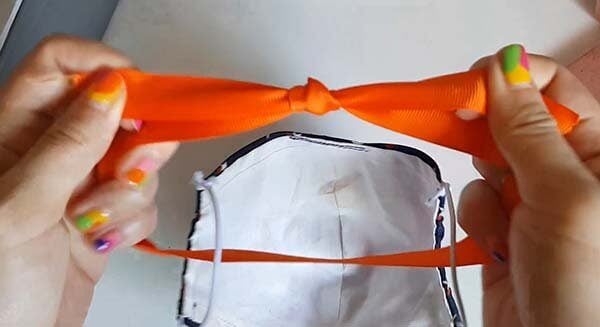
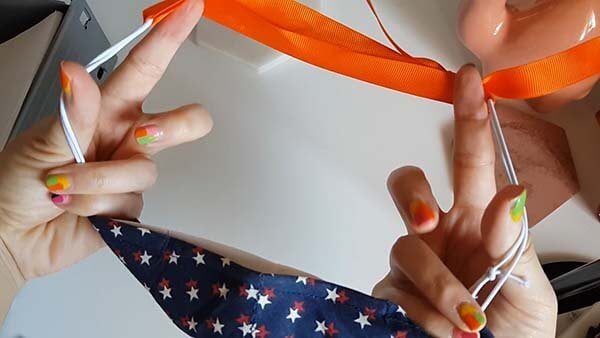
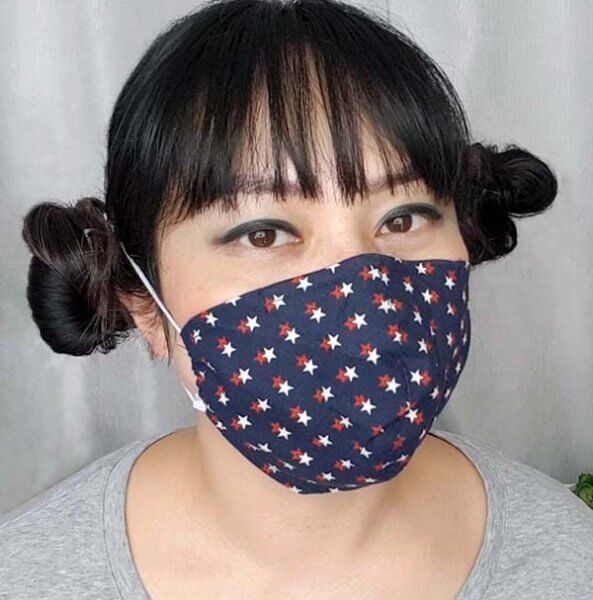
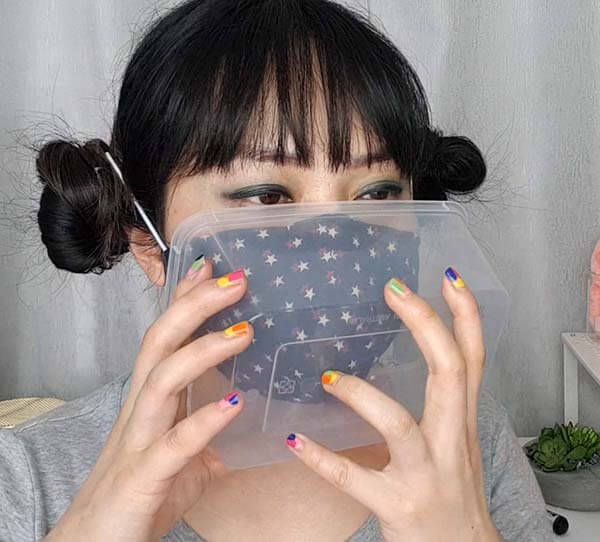
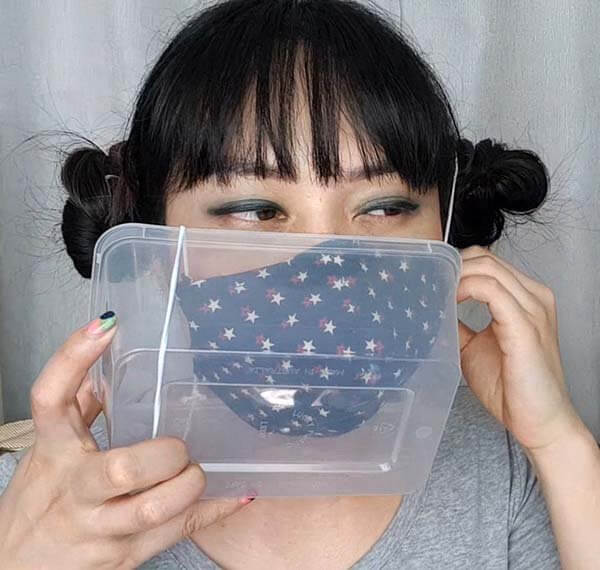



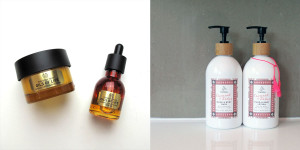

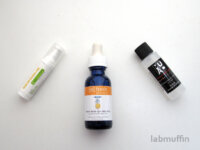
Thank you for sciencing this!
I’m glad you liked it!
Good idea with zhe princess Lea hairdo.
It works really well! 🙂
Thanks you for tour blog !
Congrats from France !
Julian
This is great. I’m a nurse and after seeing photos of Chinese and Italian nurses suffering from extreme pressure sores etc, I began thinking of ways to protect my skin. I used Cavilon from 3M as well as the hydrocolloid tape. Unfortunately I developed severe allergic contact dermatitis to surgical masks. So I’m working in an office at the hospital instead. I hope your advice can help so many others who are suffering as I was.
Ouch, that sounds terrible! I’m really glad your hospital could reassign you 🙂
Very helpful! I’m a healthcare worker and the N95 mask is so painful on my nasal bridge because I happen to have a big nose and the redness lasts for a few days and never fully goes away.
I want to try pressure relief every 1-2 hours but I am worried about compormising the integrity of the mask since I have to use the same mask for the whole day.
Argh that sounds horrible! Hope you get used more to the pressure over time 🙁
The food container hack is really helpful, thanks!
It’s such a fantastic hack! I’m going to be using it a lot 🙂
I love the container trick – taking the mask off when I know I needed to put it back on again was always such a struggle.
Another method for making the ear straps more comfortable is to sew buttons on to a cloth headband (checking exact placement), and then hook the straps onto them. I haven’t tried this, but I saw some health workers post it online, and it looked ingenious.
Can I ask where you got your reusable cloth mask from? I
My aunt sewed it for me, there are lots of patterns you can find online! 🙂
Michelle’s mask looks very much like the Olson pattern mask. This is the one I’ve been sewing for friends and family.
thanks for sharing this, very helpfull
Thanks for reminding me that wearing a heavy foundation can cause me acne because of the extra friction caused by the mask. I noticed that I started having breakouts when I wore masks all the time so I’m suspecting that it might be the reason why. Before using any products, it might be better if I can consult an expert in dermatology first to see if it is suited for my condition.
Great article here. Really needed this especially since my face gets irritated easily. Thanks a lot!
Helpful information. Great for article for people who gets skin irritation easily especially this pandemic.
Thanks!